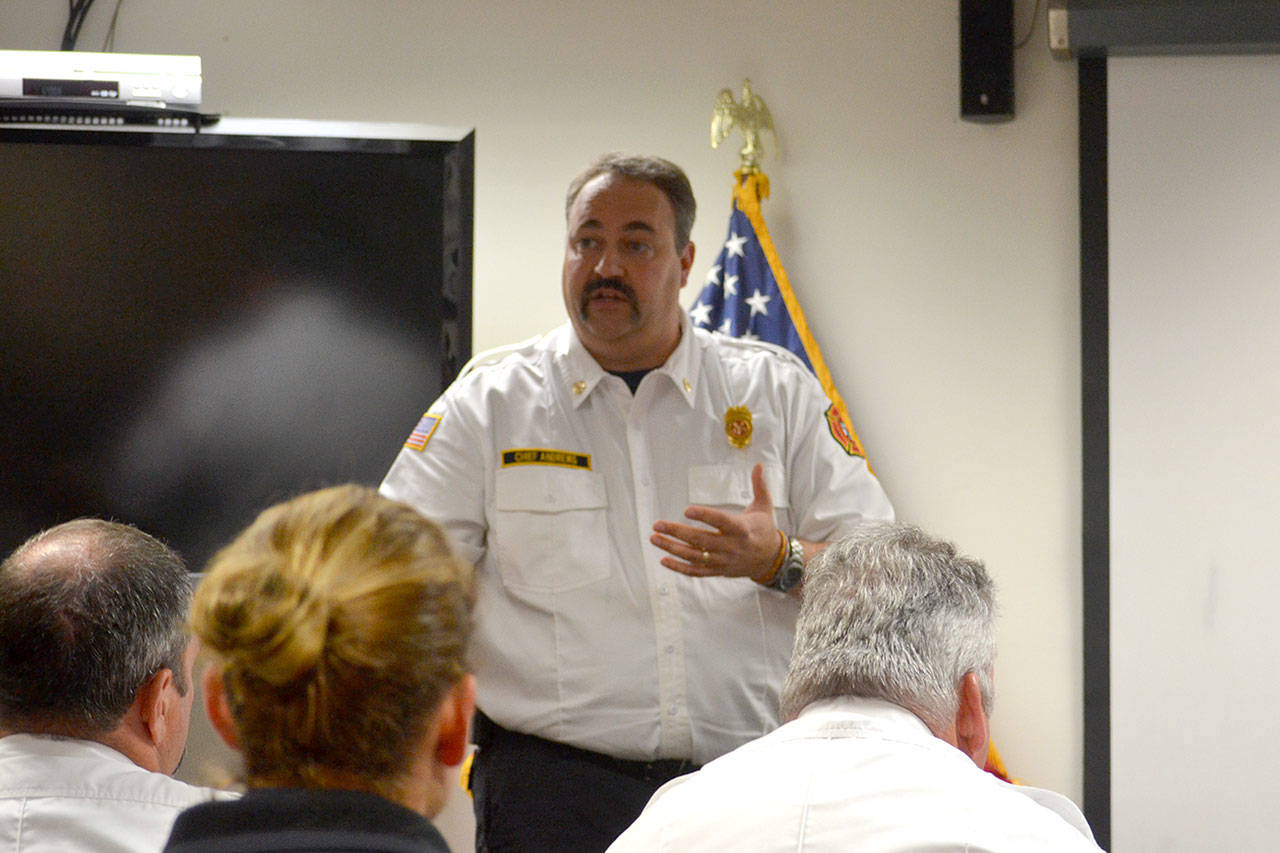Despite the possibility to add six full-time firefighters to the workforce, Clallam County Fire District 3 fire commissioners opted not to accept a three-year federal grant due to concerns over future finances once the grant ends.
Fire commissioners James Barnfather and Michael Gawley, with Steve Chinn absent, voted at the fire district’s regular meeting on Sept. 19 against accepting the Federal Emergency Management Agency’s (FEMA) matching grant. It would have given the district about $1.007 million over three years to cover 75 percent of wage and benefit costs in 2018 and 2019 and 35 percent in 2020. It would have cost the district about $1.1 million over three years though, staff said.
The grant, called SAFER, Staffing for Adequate Fire and Emergency Response, would have been the first time the district added to its workforce since 2008. Currently, the district has 47 full- and part-time employees.
Barnfather said the grant sounds enticing on the surface but there is a caveat.
“To me, this presents more like a loan with an immense balloon payment with no additional revenue source to support it,” he said.
Gawley found the financial position it’d put the department in “not acceptable.”
“It has been recommended by our accountant to maintain 40-percent reserves and right now we’re at 19-percent and it’s dwindling,” he said.
Fire district officials spoke about the grant in a special meeting one week prior where they said it could alleviate work loads, add training time and improve emergency response times. However, they said adding the positions could mean dipping into reserves and leading the fire district to possibly turn to voters for support to increase tax support sooner than expected.
Assistant Chief Eric Quitslund said if six firefighters were added, they’d work out of Station 34 on Fifth Avenue, which is also the district’s busiest.
Quitslund said it would increase the station’s on-duty firefighters from four-six full-time firefighters, and in the district from eight-10 full-time firefighters.
He said part of the goal of the grant is to help the district increase its response times, such as at significant events like structure fires where district officials seek at least 15 personnel on scene within nine minutes at least 90 percent of each similar incident.
Assistant Chief Tony Hudson said the district’s call volume has increased significantly in recent years from 5,115 in 2008 to 7,336 in 2016.
Grant details
The grant didn’t include funding for overtime, training and equipment that the district will need to pay, district officials said.
Alwynn Movius, finance manager for the fire district, estimates that to add six firefighters at entry level in 2018 including the grant covering 75 percent of wages/benefits would cost the district about $293,500.
After the grants end in 2021 and maintaining current expenditures, the six firefighters would cost about $848,900. Both amounts in 2018 and 2021 include approximate costs for equipment, training and more miscellaneous expenses.
Barnfather said it was clear accepting the grant would create more of a burden even with the unknown outcome of the department’s still-pending collective bargaining agreement.
Gawley said he doesn’t ever want to be in a position where the department needs to layoff employees.
“It shows poor financial planning, and we can do better than that,” he said. “Every employee here deserves job security.”
He added he wants to be proactive with the budget telling the public in the future, “we have a constructive plan going forward. We’ve thought this out beforehand and we know what we’re doing with the funds.”
Both commissioners said they recognize a future need to add firefighters.
“To roll he dice with taxpayer money in hopes that revenue will maybe come is a gamble I am not willing to take,” Barnfather said.
Planning ahead
Last year, the fire district hired Fitch &Associates LLC for $50,000 to conduct a study of the district ranging from from response times to facility assessments.
In the study, it says the district isn’t at capacity for call load, but it could be within three years.
Fire Chief Ben Andrews said on Sept. 12 the district’s philosophy has been not to wait for a crisis to add on.
“We previously staffed ahead of need (as with Station 37),” he said.
By late 2018, district staff anticipate expenses exceeding revenue if status quo numbers remain such as the EMS levy increasing 1.5 percent annually and the general levy at 1.75 percent each over five years.
Andrews said the revenue stream doesn’t account for anticipated short-term finances such as replacing new apparatuses such as self-contained breathing apparatuses (at about $628,000), putting a new chassis on an ambulance (about $120,000) and the updated collective bargaining agreement.
“We don’t want to make it seem like these are a burden,” he said. “The problem is down a few years later anyways even if we take action or not (on accepting the grant). We’re going to have to do something to maintain that level and possibly move that date up sooner.”
Andrews said the district is “going to need to take action” with either proposing a levy lid lift (tentatively to propose a $1.50 per $1,000 assessed home value) and/or an excess levy to maintain current standards along with accounting for the new, needed expenses.
The district previously collected a $1.50 valuation but due to home values going down, the current rate is $1.33.
“It’s not just labor costs, but the cost of doing business,” he said.
“The 1-percent (allowable by state law levy increase in) revenue is not sustainable. With the SAFER grant and status quo and collective bargaining, we’re going to see reserves go down with collective bargaining (anyways).”
Andrews said excess levy proposals are becoming more common statewide to fund other items such as equipment.
“Everyone else is experiencing what we are,” Andrews said. “One-percent revenue is not matching 3-5 percent increases.”
For more information on Clallam County Fire District 3, visit www.ccfd3.org or call 360-683-4242.



